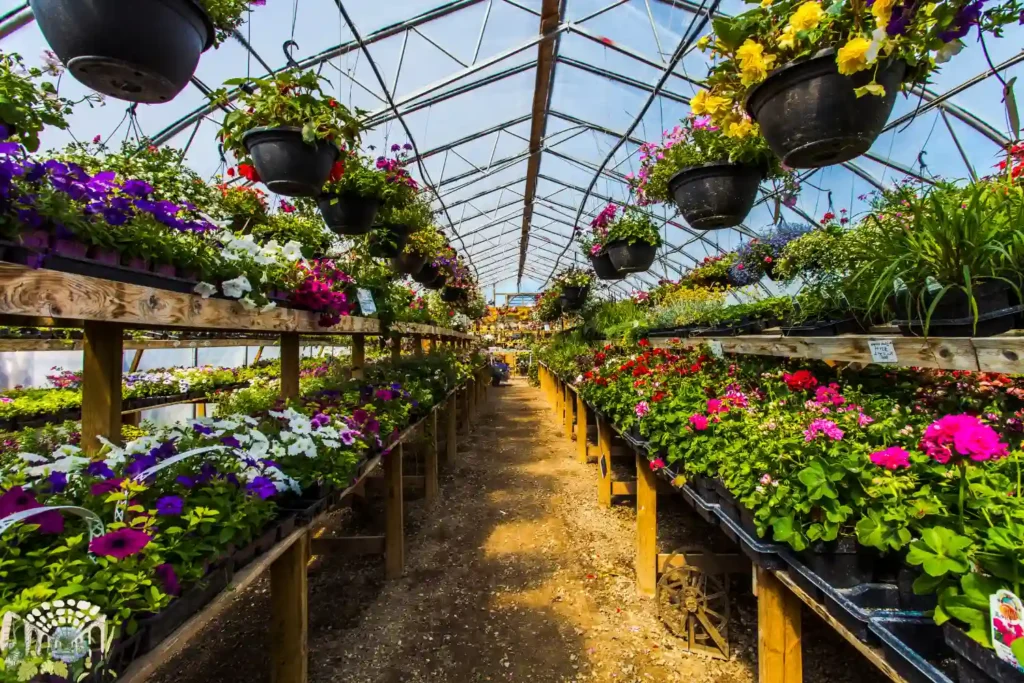Greenhouse gardening allows you to grow fresh vegetables, herbs, and flowers all year round, regardless of the weather. You can create a thriving, controlled environment that supports healthy plant growth with the right approach. This guide will help you get started and understand everything you need to make greenhouse gardening a success.
Why is a Greenhouse Necessary?
Why Does a Greenhouse Help Plants Grow Better?
A greenhouse shields plants from extreme temperatures, heavy rain, and strong winds, creating a stable environment for growth. It also allows you to control humidity, temperature, and light exposure, which helps plants flourish. Additionally, a greenhouse can protect crops from common pests and diseases that often harm outdoor plants.
Getting Started with Greenhouse Gardening
The Essentials for Beginners – Greenhouse Gardening 101
If you’re new to greenhouse gardening, start with the basics:
- Choosing the right greenhouse type: Options include glass, polycarbonate, or plastic-covered structures.
- Selecting a location: Place your greenhouse where it gets plenty of sunlight.
- Ventilation: Ensure good airflow to prevent mold and mildew.
- Temperature control: Use thermometers, shading, and heating as needed to keep conditions stable.
Greenhouse Gardening for Beginners – Where Do I Start?
Start by deciding what plants you want and preparing the right soil and containers. Begin with easy-to-care-for plants and gradually expand as you gain experience.
How to Use a Greenhouse in 6 Steps
Step 1: Planning
Define your goals for the greenhouse, whether it’s for seedlings, growing food, or protecting delicate plants.
Step 2: Sowing Seeds Indoors
Use trays with a nutrient-rich soil mix to start seeds. Keep them moist and in a warm, well-lit area for optimal germination.
Step 3: Growing On
As seedlings develop, transplant them into larger pots or greenhouse beds.
Step 4: Planting
Arrange plants with enough space for growth and proper light exposure.
Step 5: Summer Maintenance
During hot months, increase ventilation and shade to prevent overheating.
Step 6: Winter Maintenance
Insulate your greenhouse using bubble wrap or thermal mass solutions to maintain warmth.
Choosing the Right Plants for Your Greenhouse
Easy Plants for Greenhouse Starters
Start with plants that are resilient and require minimal maintenance:
- Vegetables: Tomatoes, lettuce, cucumbers, and peppers.
- Herbs: Basil, mint, chives, and parsley.
- Flowers: Marigolds, geraniums, and petunias.
Our Favourite Easy-to-Grow Greenhouse Vegetables, Fruits, Herbs & Flowers
If you’re looking for variety, consider adding:
- Vegetables: Spinach, radishes, and carrots.
- Fruits: Strawberries and dwarf citrus trees.
- Herbs: Oregano, rosemary, and thyme.
- Flowers: Sunflowers and pansies.
Understanding Greenhouse Growing Conditions
Temperature Control
Use thermometers and adjust ventilation, shading, or heating to stabilize temperatures.
Light
Ensure your greenhouse gets enough sunlight. If needed, supplement with grow lights.
Watering
Water plants consistently, but avoid overwatering to prevent root rot.
Humidity
Manage moisture levels to prevent mold and fungal diseases.
Ventilation
Ensure proper air circulation using vents, fans, or windows.
Soil
Use high-quality soil and enrich it with compost regularly.
Starting Seeds in Your Greenhouse
Starting Seeds
Use trays and a lightweight potting mix to ensure proper germination.
Hybrid Seeds vs. Heirloom Seeds
- Hybrid seeds: Bred for higher yield and resistance but do not produce identical offspring.
- Heirloom seeds: Open-pollinated varieties that can be saved and regrown.
Seed Labels and Their Meanings
Look for details like germination time, planting depth, and light requirements.
Essential Accessories for Greenhouse Gardening
Accessories to Improve Greenhouse Efficiency
- Shelving & Benches: Organize plants efficiently.
- Thermometers & Hygrometers: Track temperature and humidity.
- Shade Cloths: Reduce excess heat in the summer.
- Watering Systems: Drip irrigation keeps plants hydrated efficiently.
- Ventilation Equipment: Fans and vents improve airflow.
Common Challenges and How to Overcome Them
Pests Control for Greenhouse Starters
Protect plants from common pests like aphids, spider mites, and whiteflies by:
- Using natural predators like ladybugs.
- Applying organic insecticides like neem oil.
- Keeping the greenhouse clean.
These Are the Top Pests to Look Out For
- Aphids: Small, sap-sucking insects.
- Whiteflies: Tiny white insects that feed on leaves.
- Spider Mites: Cause yellow spots on leaves.
Common Greenhouse Gardening Mistakes
- Overwatering, which leads to root rot.
- Poor ventilation causes mold and mildew.
- Not rotating crops, which depletes nutrients.
How to Maintain Your Greenhouse Efficiently
How to Heat Your Greenhouse on a Budget
- Use soil-warming cables: Helps maintain root warmth.
- Install blinds: Captures natural sunlight for insulation.
- Bubble wrap insulation: Reduces heat loss during winter.
Frequently Asked Questions
1. How can I prevent overheating in my greenhouse?
During warm months, open vents and windows, use shade cloths and install fans to increase airflow. Keeping water containers inside the greenhouse can also help stabilize temperatures by absorbing excess heat.
2. What is the best way to fertilize greenhouse plants?
Use organic compost, worm castings, or liquid seaweed fertilizer for balanced nutrients. Avoid synthetic fertilizers that can cause nutrient buildup in the soil.
3. Can I grow tropical plants in a greenhouse?
Yes, but tropical plants require high humidity and warm temperatures. Consider installing a small heater and misting system to maintain the right conditions.
4. What is the best way to clean a greenhouse?
Regularly remove plant debris and disinfect surfaces with a mild vinegar or soap. Clean windows to allow maximum sunlight, and frequently check for mold or pest infestations.
5. How do I know when my greenhouse soil needs changing?
If plants are struggling despite proper care, or if you notice excessive salt buildup or poor drainage, it may be time to replace or refresh the soil with compost or new potting mix.




